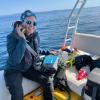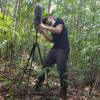Acoustic sensors enable efficient and non-invasive monitoring of a wide range of species, including many that are difficult to monitor in other ways. Although they were initially limited in application scope largely due to cost and hardware constraints, the development of low-cost, open-source models like the Audiomoth in recent years has increased access immensely and opened up new avenues of research. For example, some teams are using them to identify illicit human activities through the detection of associated sounds, like gunshots, vehicles, or chainsaws (e.g. OpenEars).
With this relatively novel dimension of wildlife monitoring rapidly advancing in both marine and terrestrial systems, it is crucial that we identify and share information about the utility and constraints of these sensors to inform efforts. A recent study identified advancements in hardware and machine learning applications, as well as early development of acoustic biodiversity indicators, as factors facilitating progress in the field. In terms of limitations, the authors highlight insufficient reference sound libraries, a lack of open-source audio processing tools, and a need for standardization of survey and analysis protocols. They also stress the importance of collaboration in moving forward, which is precisely what this group will aim to facilitate.
If you're new to acoustic monitoring and want to get up to speed on the basics, check out these beginner's resources and conversations from across the WILDLABS platform:
Three Resources for Beginners:
- Listening to Nature: The Emerging Field of Bioacoustics, Adam Welz
- Ecoacoustics and Biodiversity Monitoring, RSEC Journal
- Monitoring Ecosystems through Sound: The Present and Future of Passive Acoustics, Ella Browning and Rory Gibb
Three Forum Threads for Beginners:
- AudioMoth user guide | Tessa Rhinehart
- Audiomoth and Natterjack Monitoring (UK) | Stuart Newson
- Help with analysing bat recordings from Audiomoth | Carlos Abrahams
Three Tutorials for Beginners:
- "How do I perform automated recordings of bird assemblages?" | Carlos Abrahams, Tech Tutors
- "How do I scale up acoustic surveys with Audiomoths and automated processing?" | Tessa Rhinehart, Tech Tutors
- Acoustic Monitoring | David Watson, Ruby Lee, Andy Hill, and Dimitri Ponirakis, Virtual Meetups
Want to know more about acoustic monitoring and learn from experts in the WILDLABS community? Jump into the discussion in our Acoustic Monitoring group!
Header image: Carly Batist


- 0 Resources
- 14 Discussions
- 3 Groups
- 0 Resources
- 0 Discussions
- 4 Groups
- @laurenharrell
- | she/her/they/them
Data scientist/statistician working in bioacoustics and species distribution models, loves whales

- 0 Resources
- 0 Discussions
- 3 Groups
A Wildlife Biologist interested in Environment Assessment and Restoration, In-situ and Ex-situ strategies, Technologies used in Conservation and Illegal Wildlife Trade.
- 0 Resources
- 5 Discussions
- 13 Groups
Cornell University


- 0 Resources
- 0 Discussions
- 6 Groups
- @Jackeline
- | She
- 0 Resources
- 0 Discussions
- 7 Groups
- @owenmartin22
- | He/Him
I am a firefly researcher and wildlife painter based in Boulder, Colorado
- 0 Resources
- 0 Discussions
- 4 Groups
- @Markbowler
- | He/Him
University of Suffolk
Wildlife distributions and the effects that human activity has on populations. Spatial ecology of Amazonian mammals through audio and camera surveys. Hunter and gun tracking in Peru. Bats in suburban and agricultural landscapes in the UK
- 0 Resources
- 1 Discussions
- 9 Groups
A wildlife scientist, focusing mainly in primates conservation & research, Community-based conservation and ecosystems management.
- 0 Resources
- 0 Discussions
- 6 Groups
Texas A&M University
- 1 Resources
- 3 Discussions
- 2 Groups
- @RHugtenburg
- | He/They
Student at Aberystwyth University. Bug Fanatic🪲. Worked at Octophin Digital for my industrial year placement 🐙.
- 0 Resources
- 0 Discussions
- 20 Groups
- @Xavier_Mouy
- | he/him
I build software and hardware tools to help the analysis or the collection of passive acoustic data.
- 1 Resources
- 6 Discussions
- 6 Groups
April 2024
June 2024
July 2024
event
January 2023
event
November 2022
event
event
event
Virtual Meetup Discussion: Acoustic Monitoring
10 March 2020 2:31pm
19 April 2020 8:09pm
Where would I be able to find the recording of this virtual meetup? Thanks!
20 April 2020 9:45am
Hi Carly,
The recording + our notes is here:
WILDLABS Virtual Meetup - Acoustic Monitoring
We also keep an archive of all past meetups here:
https://www.wildlabs.net/virtual-meetups
Steph
WILDLABS Community Call Recording: Rainforest X-PRIZE
30 March 2020 12:00am
Acoustic monitiring virtual meetup recording
27 March 2020 10:14am
Prior work on Bird Flock identification
22 March 2020 9:44am
23 March 2020 9:01pm
Hi Andrew,
Dan here—I'm one of the authors of the TinyML book! I love your Withymbe project; I've previously done work involving embedded systems and insects, and it's interesting to hear about your plans for bird flocks.
As long as you have sufficient data, you should be able to identify different bird sounds and discern them from background noise. The TinyML book has a chapter that introduces the underlying techniques, and I'd also recommend taking a look at www.edgeimpulse.com - we've built a set of tools designed to make it easy to train these types of models.
We actually recently published a tutorial on Wildlabs about this very concept:
https://www.wildlabs.net/resources/case-studies/tutorial-train-tinyml-model-can-recognize-sounds-using-only-23-kb-ram
I'm always excited to learn about new applications; feel free to reach out if there's any way we can help. I'm [email protected].
Warmly,
Dan
24 March 2020 3:49am
Just guessing but I don't think it will make much of a difference, individual or flock. The spectrogramme will look much the same, and I think that is used as the input vector to the CNN. If so then I would expect the model will be quite tolerant of flock size. Just spitballing here though.
24 March 2020 7:23am
Hi Harold!
Great to know you are in the domain. To be honest my analysis so far indicates that when conducting a DSP approach on the spectrum, smoothing via convolution becomes an issue? Basically, the raw spectrum is too jagged to match, so one convolves it to smooth it, but then one just gets a generic "noise"-shaped spectrum. I also have variances in sampled spectra from the same source recording? I am using an fs=44100 and a spectrum 0 - 64kHz initially, or though I tried to filter from 100 - 9k with little success?
My design outline is: I need to identify the presence of a flock of a certain species of avians, I need to know when the flock is not present, and I need to distinguish the presence of other flocks of birds, not to identify them, but they are sometimes similar in size and possibly, therefore, call range? A sort of "We - Not We" approach?
I am comparing the gestalt sound, not individual calls?
Plus: I am using a Rapsberry Pi for the Fog Node currently, but see that I can use my Arduino Uno for TinyML from the examples which use a Nano? I am interested in the power-saving, but need a robust microphone rig, which I currently get via usb?
I will checkout your tutorial, many thanks!
Tally ho!
Andrew.
Virtual Field Trip: Conservation Technology with Shah Selbe
 Shah Selbe
Shah Selbe
24 March 2020 12:00am
Enter the Zooniverse: Try Citizen Science for Yourself!
 Ellie Warren
Ellie Warren
18 March 2020 12:00am
Tutorial: Train a TinyML Model That Can Recognize Sounds Using Only 23 kB of RAM
 Daniel Situnayake
Daniel Situnayake
16 March 2020 12:00am
Success recording bees using AudioMoth
7 July 2019 6:45pm
11 March 2020 11:16am
How can we learn more about your BEESWAX7 buzz identification and counting program, and discuss working together?
#Tech4Wildlife 2020 Photo Challenge In Review
4 March 2020 12:00am
Listening to Nature: The Emerging Field of Bioacoustics
 Adam Welz
Adam Welz
24 February 2020 12:00am
Workshop: Using Bioacoustics for Field Survey
 CIEEM
CIEEM
20 February 2020 12:00am
ICEI2020: 11th International Conference on Ecological Informatics
 ICEI 2020
ICEI 2020
14 February 2020 12:00am
WILDLABS Virtual Meetup Recording: Acoustic Monitoring
5 February 2020 12:00am
Acoustic Telemetry Workshop Series
 Ocean Tracking Network
Ocean Tracking Network
19 December 2019 12:00am
Machine-readable representation of a sensor duty cycle / recording schedule
11 September 2019 8:13pm
12 September 2019 5:27pm
Hi David,
I use cron-like patterns. One form looks something like: mon,wed-sun 0-23:0-59/10 90
which means every day but Tuesdays, every 10 minutes from the top of the hour, recording for 90 seconds. There is a similar form for matching by month/day. There could be yet another form for sunrise/sunset but I haven't implemented that. Basically a hyphen indicates a range, a comma indicates a list, and the slash is repetition step size. A full recording specification consists of one or more patterns, the first matching being used (for the recording duration). Years are not implemented but that could be done also.
Thanks,
-harold
Advice on Audiomoth extended power and case solution
3 September 2019 5:56pm
6 September 2019 11:21am
Hi Shawn,
I might be concerned about the Li-ion batteries, if there is any chance of losing a node (damage due to installation, weather, animals, or theft) then the economics won't work out, it being such a large proportion of the cost. Also it's kind of a pain flying with them even if they're quite light because they have to go in carry-on luggage.
I'm not insensitive to the e-waste issue, but here I think even here alkaline might have the upper hand: many lithium cells contain toxic cobalt (as opposed to manganese) and it's not often clear which type you have. Alkalines OTOH are relatively innocuous (unless they contain mercury, which they should not in this day and age): carbon anode, steel casing, zinc cathode, zinc oxide (used in baby nappy rash cream), lye, manganese oxide/dioxide (occurs naturally as an ore but you still don't want to eat it).
Thanks,
-harold
6 September 2019 5:29pm
Many thanks Harold!
I really appreciate the information on e-waste! What about going with LiFePo4 batteries? They are consider low toxicity and I know they are a type of battery that our chemistry department will take to recycle (they will also take lipo and li-ion). I am trying to figure out how to calculate battery life in the Audiomoth if I were to go with a higher voltage LiFePo4 but less mAh, say 6.6 volt and 2100/3000 mAh. Any suggestions? and of course thoughts on this option? These batteries are cheaper too ($11-15)!
I've worked a lot with lipo and li-ion batteries building drones and other power solutions so I'm not really worried about damaging them or transporting them. It's amazing how many huge lipo's I've had in my carry-on luggage and all they care about is my laptop! My main concern with alkaline is that they are expensive in Ecuador with no where to dispose of for recyling (yet or that I currently know of). Rechargeables make sense because of the long-life and they can be muled back to the university for recyling with the chemistry department (I have no idea what they do with them, they just want them and say they will be recycled).
Shawn
7 September 2019 12:33am
Hi Shawn,
I've only heard good things about LiFePO4. The only issue I can think of is exactly the one you bring up: the EMF is low enough that a 2S battery is needed. The Audiomoth uses a linear voltage regulator, so anything in excess of the 3.3V that is actually used is wasted. This means for endurance calculations you consider only the mAH rating given you have chosen a battery that will output at least 3.3V (plus a bit more for the dropout). So 2100mAH at 6.6V is just 2100mAH, compared with 5000mAH of your initial Li-ion.
A high-effiency switching regulator may make sense if you're running the Audiomoth at high duty, but even so finding a low power unit is hard. But since reliability is paramount, I would go with something with the fewest moving parts.
Thanks,
-harold
Audio analysis of flocks or swarms
1 July 2019 3:57pm
9 July 2019 1:00am
Hi Andrew,
I'm not a signals guy I'm afraid, but I was thinking perhaps one way might be to estimate the physical size of the flock/swarm by scanning with a microphone array.
BTW do you find it a problem if an individual happens to be too close and drowns out the rest? In part it's a question of dynamic range but also of sensor placement.
Thanks,
-harold
21 August 2019 3:38pm
So far we have been able to disambiguate between the flocks of two different species of small birds? Not easy. Our problem seems to be based around the fact that some or all flocks of small birds cheeping sound pretty similar? Of course the issue is: at what point is asynchronous sound aggregation just noise?
With regards to individual sounds, we are not interested in individuals at the moment so have not tested for it. I suspect however that in the interests of completeness we will be?
More anon,
Andrew.
Raspberry Pi Hardware Mono Mic Problem
4 June 2019 3:47pm
24 July 2019 5:26pm
We've had good results with two mono inputs accepted via the stereo 1/4" input jack on the Pisound HAT on a 3B+ and just about to test with the 4. Details and links to Pisound folks in Lithuania here -- http://www.orcasound.net/2018/04/27/orcasounds-new-live-audio-solution-from-hydrophone-to-headphone-with-a-raspberry-pi-computer-and-hls-dash-streaming-software/
26 July 2019 9:50pm
Hey Scott,
Thanks for the advice, it is greatly appreciated. That's a very interesting project as well! I will have a read through it all in detail.
Sam
21 August 2019 3:22pm
Hi Sam,
have you tried the Clippy EM172 ? I was looking at this microphone on Raspberry Pi + PiSound, but it has an electret capsule and should then be powered...
Thank you !
Sound Event Recognition - through collaboration
28 June 2017 9:13pm
10 April 2018 2:19pm
no, you didn't miss it. We don't share it with the general public. Only with serious partners ;-)
9 July 2019 9:42pm
@jankees,
Hi I am working on a system to reduce Human Elephant Conflict and am interested in acoustics of Elephants and the identification of elephants through their acoustic signature to assist with this project, did you get anywhere with the serval sensor for detecting Elephants?
We are a non profit called the Forgotten Parks Foundation and currently managing the Upemba and Kundelungu National Parks in the DR.Congo and have an immediate requirement to reduce HEC so we would like to assist with the development of such a system.
10 July 2019 7:15am
Hi Kev,
thank you for contacting us. We are a non-profit, too. I very much welcome collabortion on this system. Shall we continue our discussion through email? Mine is [email protected].
Looking forward to discussing this further,
Jan Kees
Technology lab focused on wildlife protection opens on Ol Pejeta Conservancy
 Ol Pejeta Conservancy
Ol Pejeta Conservancy
31 May 2019 12:00am
WILDLABS TECH HUB Showcase
17 May 2019 12:00am
Meet the WILDLABS TECH HUB Winners
13 May 2019 12:00am
Bird Bioacoustics - Good Practice Guidance
11 April 2019 9:42pm
WILDLABS Virtual Meetup: Low Cost, Open-Source Solutions
18 March 2019 12:00am
AudioMoth 2.0 Development
17 March 2019 2:44am
AudioMoth user guide
27 February 2019 9:35pm
14 March 2019 10:08am
That also sounds like a good idea :)
14 March 2019 1:52pm
Hi again,
I agree; it's very important that everyone is able to contribute to the guide. Thanks for taking the lead on that, Akiba. To that end, I just made my GitHub repo publicly editable, so please feel free to add to it if you want to use a GitHub repository.
However, a Google Doc would be much easier for the general public to contribute to. If you choose that route instead, please use whatever you want from my repository. :-)
I personally like to use the guide as a single document instead of a Wiki. It's easier to read through, and since everything is on the same page, you can just CTRL+F to find a specific word or section. Also, it's helpful to be able to download it as a .pdf, or print it out and refer to it in the field.
Tessa
14 March 2019 3:43pm
Hi Tessa.
Thanks and also thanks for being so generous with your work :)
Regarding the format, how do you all think if we have a single document and a wiki? I could handle the single document if David wanted to do the wiki. One potential issue would be synchronization, but since many wikis keep a change list, perhaps we can schedule periodic document updates based on the wiki changelists. We can also maintain a document changelist in case the changes need to go in the other direction.
Any comments or suggestions?
Akiba
Advice for an in-situ Audio-Visual system for recording at a nest site
9 February 2019 6:19pm
25 February 2019 6:37pm
Hello Carlos and Sam
That book on "CCTV for Wildlife Monitoring" looks excellent. Although it is somewhat off at a tangent of my actual work this looks way too useful not to have. There are cheaper second-hand copies on Abebooks and eBay and also on sale at NHBS, £20.98 incl. UK P&P (https://www.nhbs.com/cctv-for-wildlife-monitoring-book).
An interesting interview with the author, Susan Young: https://blog.nhbs.com/author-interviews/interview/cctv-for-wildlife-monitoring-an-interview-with-susan-young/
Meanwhile, I have come across a research project by the author of that book using technology that looks very close to what Sam is trying to do: "CCTV Enables the Discovery of New Barbastelle Vocalisations and Activity Patterns Near a Roost - We monitored a barbastelle maternity roost for four months using a portable CCTV system, time synchronised with ultrasound recorders."
See more here: https://www.researchgate.net/project/Using-CCTV-to-link-vocal-repertoire-with-behaviour-in-bats
If the above does not do it, I think you should contact the author and get her advice on what would be a suitable setup for you. That's what I meant in my earlier post about maximising use of previously developed solutions. It will just save you a lot of messing about, especially if you are not a technical expert yourself.
I hope this is of some use. Do post an update when you have worked out what equipment to use.
Good luck,
Joachim Neff
6 March 2019 7:42pm
Hello Sam
I have now received the book on "CCTV for Wildlife Monitoring" (see my earlier post for more details) and it is as excellent as it looked online. If you can spare £21 then I would suggest you get a copy yourself.
The book is written for those without much technical background and the case studies are very detailed with equipment lists and setup details. I have not read the entire book but as far as I can see there are no examples described specifically with synced audio. However, all the case studies and detailed comments on what to watch out for (pun intended) should give you a lot of help in working out what you need for your project.
Good luck,
Joachim
8 March 2019 2:44pm
Joachim and Carlos,
Thank you both very much for all your help so far with this problem, all of your input is very constructive. I have had look into the CCTV tech and also that researchgate link, and both have provided me with a few more options. At the moment I am organising a visit to one of the "hackerspaces" near me, to see if anyone can give me some hands-on practical advice, mainly about a suitable power supply solution (as lots of inputs running and recording continuously will reduce the time it can be in-field substantially based upon a standard, small size power supply, as I understand it). I will let you both know when I have managed to develop a prototype, but this may take a month or two as I need to first order a starter kit for Raspberry Pi or Arduino, get my head around the basics, and also contend with my other work. I will be sure to let you all know if I make any headway!
Best wishes,
Sam
#Tech4Wildlife Photo Challenge: Our Favourites from 2019
3 March 2019 12:00am
Real-time audio monitoring
19 February 2019 10:42am
22 February 2019 2:33pm
Hi,
What you're asking, is it conceptually like turning on the mic on your PC and doing something with the output from the sound card? Instead of digitising the sound it's possible to do some kind of monitoring in the analogue domain. It sounds like an interesting problem, tell me more!
Thanks.
1 March 2019 8:17am
What frequecy are you looking to record, how long does the mic need to run for, what is the distance between the microphone and the "listening" site? As (unless I've missed something) an off the shelf radio microphone does exactly that job.
Bioacoustics for Ecologists: Hardware, Survey Design and Data Analysis
 PR Statistics
PR Statistics
25 February 2019 12:00am




























28 March 2020 8:24am
Hi all,
I missed this, but just watched the virtual meeting recording. Towards the end Stephanie mentioned there were many questions about recording multiple channels for localisation. I hadn't thought there was that much interest in it. Anyway my collaborator/client and I have been working on this off and on and slowly, but she did present some results she got at the recent conference in NZ. If there is any interest I'll see if I can get her to give out her slides or something.
On another tack I'm interested in the experience of anyone who has done gunshot/blast fishing localisation. In particular I'm curious about the algo used for detection and also for localisation. I'm taking the matched filter approach for detection but am now wondering if maybe CNN classification might be better.
Finally I'm interested if anyone has ideas about implementing a LoRa mesh, or knows of a useable mesh layer.
Thanks,
-harold